Bomag BW 145 D-3, BW 145 DH-3, BW 145 PDH-3 Operator Manual

Operating instructions
Maintenance instructions
BW 145 D-3 / DH-3 / PDH-3
S/N 101 581 21.... |
901 581 47 .... |
S/N 101 581 22.... |
901 581 48 .... |
S/N 101 581 23 .... |
901 581 49 .... |
Single drum roller
Catalogue number
008 157 08 |
01/2004 |


BOMAG machines are products from the wide range of BOMAG compaction equipment.
BOMAG's vast experience, together with the most up-to-date production and testing methods, including service life tests of all important components and highest quality demands, guarantee maximum reliability of your machine.
These instructions comprise:
•Safety regulations
•Operating instructions
•Maintenance instructions
•Trouble shooting
Using these instructions will
•help you to get to know the machine.
•avoid malfunctions caused by unexpert operation.
Compliance with the maintenance instructions will
•increase the reliability of your machine on the site,
•increase the service life of the machine,
•reduce repair costs and downtimes.
BOMAG shall not assume liability for safe functioning of the machine
•if it is handled in a way which does not comply with the usual modes of use,
•if it is used for purposes other than those mentioned in the instructions.
No warranty claims can be lodged for damage resulting from
•operating errors,
•insufficient maintenance and
•wrong fuels and lubricants.
Please note!
This manual has been written for the operator and the service personnel at the site.
Keep this manual always close at hand , e.g. in the tool compartment of the machine or in the container provided.
Foreword
You should only operate the machine if you are fully familiar with the contents of these instructions.
You must also observe all applicable safety regulations.
Please observe also the guidelines of the Civil Engineering Liability Association "Safety Regulations for the Operation of Road Rollers and Soil Compactors" and the applicable accident prevention instructions.
For your own safety you should only use BOMAG-spare parts.
We reserve the right for technical modifications without prior notification.
These operating and maintenance instructions are also available in other languages.
A spare part catalogue can be obtained from your BOMAG dealer when giving him the serial number of your machine.
Information about the correct use of our machines in earth work and for asphalt applications can be obtained from your BOMAG dealer.
The above points do not constitute an extension of the warranty and liability conditions specified in the general terms of business of BOMAG.
We wish you much success with your BOMAG machines.
BOMAG GmbH & Co. OHG
Printed in Germany
Copyright by BOMAG
BW 145 D-3/DH-3/PDH-3 |
BOMAG |
3 |

Foreword
Please fill in
. . . . . . . . . . . . . . . . . . . . . . . . . . . .
Machine type (Fig. 1)
. . . . . . . . . . . . . . . . . . . . . . . . . . . .
Serial-number (Fig. 1 and 2)
. . . . . . . . . . . . . . . . . . . . . . . . . . . .
Engine type (Fig. 3)
. . . . . . . . . . . . . . . . . . . . . . . . . . . .
Engine number (Fig. 3)
i Note
Supplement the above data together with the commissioning protocol.
During commissioning our organisation will instruct you in the operation and maintenance of the machine.
Please observe strictly the safety regulations and all notes on risks and dangers!
Fig. 1
Fig. 2
Fig. 3
4 |
BOMAG |
BW 145 D-3/DH-3/PDH-3 |

Table of Contents
Technical Data |
|
|
7 |
Safety regulations |
|
|
11 |
Indicators and Controls |
|
|
19 |
3.1 |
General notes |
22 |
|
Operation |
|
|
29 |
4.1 |
General notes |
30 |
|
4.2 |
Tests before taking into operation |
30 |
|
4.3 |
Starting the engine |
31 |
|
4.4 |
Starting with jump leads |
33 |
|
4.5 |
Driving the machine |
34 |
|
4.6 |
Emergency exit |
35 |
|
4.7 |
Operating the parking brake, stopping the machine |
36 |
|
4.8 |
Shutting the engine down |
36 |
|
4.9 |
Switching the vibration on and off |
37 |
|
4.10 |
Adjusting the seat |
38 |
|
4.11 |
Operating the hood |
39 |
|
4.12 |
Towing in case of an engine failure |
39 |
|
4.13 |
Transport |
41 |
|
Maintenance |
|
|
43 |
5.1 |
General notes on maintenance |
44 |
|
5.2 |
Fuels and lubricants |
45 |
|
5.3 |
Table of fuels and lubricants |
48 |
|
5.4 |
Running-in instructions |
49 |
|
5.5 |
Maintenance chart |
50 |
|
5.6 |
|
Checking the engine oil level |
52 |
5.7 |
Checking the fuel filter water separator |
52 |
|
5.8 |
Checking the fuel level |
53 |
|
5.9 |
Checking the hydraulic oil level |
54 |
|
5.10 |
Checking the tire pressure |
55 |
|
5.11 |
Cleaning the cooling fins on the radiator |
55 |
|
5.12 |
Cleaning the cooling fins on the hydraulic oil cooler |
56 |
|
5.13 |
Check the oil level in the drive axle |
57 |
|
5.14 |
Checking the oil level in left/right wheel hubs |
58 |
|
5.15 |
Checking the oil level in the vibration bearings |
58 |
|
5.16 |
Servicing the battery |
59 |
|
5.17 |
Draining the sludge from the fuel tank |
60 |
|
5.18 |
Change engine oil and oil filter cartridge |
60 |
|
5.19 |
Checking the V-belt tension, tightening |
62 |
|
5.20 |
Checking, adjusting the valve clearance |
63 |
|
5.21 |
Changing the oil in the vibration bearings |
64 |
|
5.22 |
Change the oil in the drive axle |
65 |
|
BW 145 D-3/DH-3/PDH-3 |
BOMAG |
5 |

Table of Contents
5.23 |
Change the oil in the wheel hubs |
66 |
5.24 |
Changing the fuel pre-filter |
67 |
5.25 |
Changing the fuel filter cartridge |
68 |
5.26 |
Checking the fastenings on the diesel engine |
68 |
5.27 |
Tightening the fastening of the axle on the frame |
69 |
5.28 |
Tightening the wheel nuts |
69 |
5.29 |
Checking the ROPS |
70 |
5.30 |
Changing hydraulic oil and breather filter |
71 |
5.31 |
Changing the hydraulic oil filter |
72 |
5.32 |
Checking the injection valves |
74 |
5.33 |
Replacing the toothed belt |
75 |
5.34 |
Checking, cleaning, changing the combustion air filter |
76 |
5.35 |
Adjusting the parking brake |
79 |
5.36 |
Changing the tires |
80 |
5.37 |
Adjusting the scrapers |
81 |
5.38 |
Changing the fresh air filter in the cabin |
82 |
5.39 |
Tightening torques |
82 |
5.40 |
Engine conservation |
83 |
Trouble shooting |
|
85 |
6.1 General notes |
86 |
|
6.2 Engine |
87 |
|
6 |
BOMAG |
BW 145 D-3/DH-3/PDH-3 |

1 Technical Data
BW 145 D-3/DH-3/PDH-3 |
BOMAG |
7 |
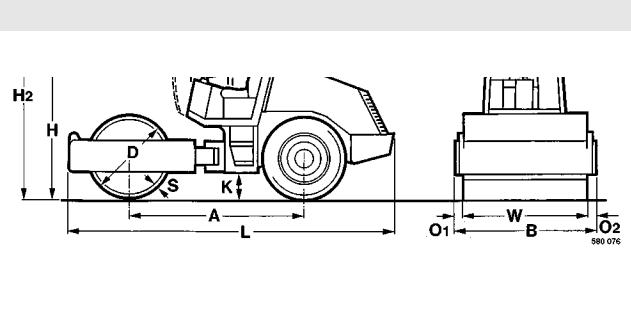
Technical Data
Fig. 4
Dimensions in |
A |
B |
D |
H |
H2 |
K |
L |
O1 |
O2 |
S |
W |
mm |
|
|
|
|
|
|
|
|
|
|
|
|
|
|
|
|
|
|
|
|
|
|
|
BW 145 D-3 |
2222 |
1546 |
1058 |
1900 |
2750 |
313 |
4194 |
60 |
60 |
22 |
1426 |
BW 145 DH-3 |
2222 |
1546 |
1058 |
1900 |
2750 |
313 |
4194 |
60 |
60 |
22 |
1426 |
BW 145 PDH-3 |
2222 |
1546 |
1044 |
1900 |
2750 |
313 |
4194 |
60 |
60 |
15 |
1426 |
* |
|
BW 145 D-3 |
BW 145 DH-3 |
BW 145 PDH-3 |
|
|
|||
Weights |
|
|
|
|
Operating weight (CECE) |
kg |
4990 |
5050 |
5330 |
with ROPS-cabin |
|
|
|
|
Front axle load (CECE) |
kg |
2620 |
2680 |
2960 |
Rear axle load (CECE) |
kg |
2370 |
2370 |
2370 |
Static linear load |
kg/cm |
18,4 |
18,8 |
- |
Travel characteristics |
|
|
|
|
Travel speed (1) |
km/h |
0 ... 6 |
0 ... 5 |
0 ... 5 |
Travel speed (2) |
km/h |
0 ... 10 |
0 ... 10 |
0 ... 10 |
Max. gradability with vi- |
% |
47 |
55 |
55 |
bration |
|
|
|
|
8 |
BOMAG |
BW 145 D-3/DH-3/PDH-3 |
|
|
|
|
Technical Data |
|
|
|
|
|
* |
|
BW 145 D-3 |
BW 145 DH-3 |
BW 145 PDH-3 |
Drive |
|
|
|
|
Engine manufacturer |
|
Deutz |
Deutz |
Deutz |
Type |
|
BF4L 2011 |
BF4L 2011 |
BF4L 2011 |
Cooling |
|
Air/oil |
Air/oil |
Air/oil |
Number of cylinders |
|
4 |
4 |
4 |
Rated power ISO 3046 |
kW |
56 |
56 |
56 |
Rated speed |
rpm |
2650 |
2650 |
2650 |
Fuel |
|
Diesel |
Diesel |
Diesel |
Electrical equipment |
V |
12 |
12 |
12 |
Drive system |
|
hydrostatic |
hydrostatic |
hydrostatic |
Driven axles |
|
2 |
2 |
2 |
Brakes |
|
|
|
|
Service brake |
|
hydrostatic |
hydrostatic |
hydrostatic |
Parking brake |
|
hydr.-mech. |
hydr.-mech. |
hydr.-mech. |
Steering |
|
|
|
|
Type of steering |
|
articulated |
articulated |
articulated |
Steering operation |
|
hydrostatic |
hydrostatic |
hydrostatic |
Vibration |
|
|
|
|
Drive system |
|
hydrostatic |
hydrostatic |
hydrostatic |
Frequency |
Hz |
34 |
34 |
34 |
Amplitude |
mm |
1,7/0,85 |
1,7/0,85 |
1,4/0,7 |
Tires |
|
|
|
|
Tire size |
|
335/80R20MPT81 |
335/80R20MPT81 |
340/80R18IT530 |
Air pressure |
bar |
1,8 |
1,8 |
1,8 |
Tank contents |
|
|
|
|
Hydraulic oil |
Litres |
44 |
44 |
44 |
Fuel |
Litres |
110 |
110 |
110 |
Engine oil |
Litres |
10,5 |
10,5 |
10,5 |
*The right for technical modifications remains reserved
BW 145 D-3/DH-3/PDH-3 |
BOMAG |
9 |

Technical Data
The following noise and vibration values according to the EC-directive for machines, edition (91/368/ EEC) were measured at nominal engine speed and with the vibration switched on. The machine was standing on an elastic base.
During operation these values may vary because of the existing operating conditions.
Noise value
The sound level according to enclosure 1, paragraph 1.7.4. f of the EC-machine regulation is
sound pressure level at the work place of the operator (with cabin):
LpA |
= |
78,4 dB(A) |
sound capacity level: |
||
LwA |
= |
101,8 dB(A) |
These sound values were determined according to ISO 3744 for the sound capacity level (LwA) and ISO 6081 for sound pressure level (LpA) at the place of the operator.
Vibration value
The vibration values according to enclosure 1, paragraph 3. 6. 3. a of the EC-machine regulation are:
Vibration of the entire boy (driver’s seat)
The weighted effective acceleration value determined according to ISO 2631 part 1, is ≤0,5 m/sec2.
Hand-arm vibration values
The weighted effective acceleration value determined according to ISO 8662 part 1, is ≤2,5 m/sec2.
10 |
BOMAG |
BW 145 D-3/DH-3/PDH-3 |

2 Safety regulations
BW 145 D-3/DH-3/PDH-3 |
BOMAG |
11 |

Safety regulations
General
This BOMAG machine is built in accordance with the latest technical standard and the valid technical rules and regulations. There is, however, a risk of danger for persons and property if:
•the machine is used for purposes other than those it is intended for
•the machine is operated by untrained personnel
•the machine is modified or converted in an unprofessional way
•the applicable safety regulations are not observed.
Each person involved in operation, maintenance and repair of the machine must therefore read and apply these safety regulations. This should be confirmed by obtaining the signatures of the customer, if necessary.
Furthermore the following regulations and instructions are obviously also valid:
•applicable accident prevention instructions
•generally acknowledged safety and road traffic regulations
•country specific safety regulations. It is the duty of the operator to know and observe these regulations. This applies also for local regulations and the regulations for various types of manual work. If the recommendations in this manual differ from the regulations valid in your country, you must strictly observe the regulations in your country.
Intended use
This machine must only be used for:
•compaction of bituminous materials, e.g. road surface layers. (AC and AD machines only)
•medium and heavy compaction tasks in earth work (road sub-bases)
•This machine must only be operated with fully functional safety equipment.
•The machine should be checked by an expert once every year.
Unintended use
Dangers may, however, arise from the machine if it is used by untrained personnel in an unprofessional way or if it is used for purposes other than those mentioned in these instructions.
Do not work with vibration on hard concrete, on a cured concrete layer or heavily frozen ground.
Starting and operation of the machine in an explosive environment is prohibited.
Who is allowed to work with the machine?
The machine must only be operated by trained and authorized persons which are at least 18 years of age. The responsibilities for the operation of the machine must be clearly specified and complied with.
Persons under the influence of alcohol, medication or drugs must not operate, service or repair the machine.
Maintenance and repair tasks require specific knowledge and must therefore only be carried out by trained and qualified personnel.
Conversions and alterations to the machine
Unauthorized conversions to the machine are prohibited for safety reasons.
Original parts and accessories have been specially designed for this machine. We wish to make expressly clear that we have not tested or authorized any original parts or special equipment not supplied by us. The installation and/or use of such products can impair the active and/or passive driving safety. The manufacturer expressly excludes any liability for damage resulting from the use of non-original parts or accessories.
Safety notes in the operating and maintenance instructions:
! Danger
Sections marked like this point out possible dangers for persons.
12 |
BOMAG |
BW 145 D-3/DH-3/PDH-3 |
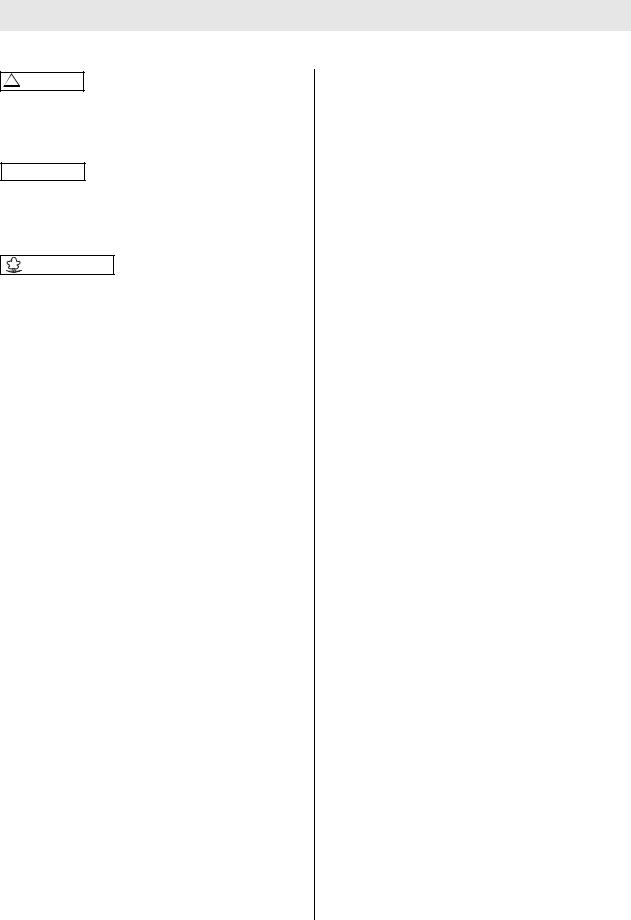
!Caution
Sections marked like this point out possible dangers for the machine or for parts of the machine.
i Note
Sections marked like this provide technical information concerning the optimal economical use of the machine.
Environment
Sections marked like this highlight activities for the safe and environmental disposal of fuels and lubricants as well as replaced parts.
Observe all environment protection regulations.
Information and safety stickers/decals on the machine
Keep stickers/decals complete (see spare parts catalogue) and fully legible and observe their meaning.
Replace damaged or illegible stickers/decals immediately.
Loading the machine
Use only strong and stable loading ramps. The ramp inclination must be lower than the gradability of the machine.
Secure the machine against turning over or slipping off.
Secure the machine on the transport vehicle against rolling off, slipping and turning over.
Persons are highly endangered if
•they step or stand under loads being lifted
•they remain in the drive range of the machine during a demonstration or during loading.
The machine must not swing about when lifted off the ground.
Use only safe lifting gear of sufficient load bearing capacity.
Attach the lifting gear only to the specified lifting points.
Safety regulations
Towing the machine
Since the machine is not fitted with a towing hitch, the machine cannot be towed with a tow bar.
If the machine has to be towed urgently out of the danger zone because of other risks, this must only be done on level ground or uphill using chains and ropes. For this purpose towing ropes of sufficient tensile strength must be fastened on the lifting eyes.
After releasing the brake the machine can only be braked by the towing vehicle.
Before releasing the brake block the machine with chocks to prevent unintended rolling.
Checking the roll-over protection structure (ROPS)
The machine frame must not be distorted, bent or cracked in the area of the ROPS structure.
The ROPS structure must not show any rust, damage, hairline cracks or open fractures.
The ROPS must not rattle about when driving the machine. This would mean that the fastening screws are insufficiently fastened. All screwed connections must be tight and in accordance with the specifications (observe the tightening torques). Screws and nuts must not be damaged, distorted or deformed.
No additional parts must be welded or bolted on and no holes must be drilled without the permission of the dealer, since this may impair the strength of the structure.
Starting the machine
Before starting
Operation of the machine is only permitted when sitting in the operator's seat.
Use only machines which have been properly serviced at regular intervals.
Become acquainted with the equipment, the control elements, the working mode of the machine and the area you will be working in.
Use your personal protective outfit (hard hat, safety boots etc.).
Check before mounting the machine if:
•there are persons or obstructions beside or under the machine
BW 145 D-3/DH-3/PDH-3 |
BOMAG |
13 |

Safety regulations
•the machine is free of any oily and combustible material
•all handrails, steps and platforms are free of grease, oils, fuels, dirt, snow and ice
•the engine compartment hood is closed and locked
To climb onto the machine use steps and handrails.
Check before starting, whether:
•the machine shows any obvious defects
•all protective devices are properly secured in their place
•steering, brakes, control elements, lighting and warning horn are in order
•the seat is correctly adjusted
•the mirrors (if available) are clean and correctly adjusted.
Do not start the machine if any gauges, control lights or controls are defective.
Do not take any loose objects with you or fasten them to the machine.
On machines with ROPS you should always wear your seat belt!
Starting
Start and operate the machine only from the operator's seat
For starting set all control levers to "neutral position".
Do not use any starting aids such as Start Pilot or ether.
After starting check all gauges.
Starting with jump leads
Connect plus with plus and minus with minus (ground cable) - always connect the ground cable last and disconnect it first! Wrong connections may cause severe damage in the electric system.
Never start the engine by bridging the electrical connections on the starter, because the machine would probably start to move immediately.
Starting in closed rooms
Exhaust gases are toxic! Always ensure an adequate supply of fresh air when starting in closed rooms!
Driving the machine
Persons in the danger area
If the machine should turn over and the cabin door is closed, the right hand side cabin window can be used as an emergency exit.
Check if there are persons or obstacles in the danger area before starting or resuming work, especially when driving in reverse.
If necessary give warning signals. Stop work immediately, if persons remain in the danger area despite the warning.
Do not stand in the machine's articulation area while the engine is running. Danger of injury!
Driving
In emergency situations and in case of danger operate the emergency stop switch immediately. Do not use the emergency stop switch as service brake.
Resume operation only after eliminating the danger that has led to the actuation of the emergency stop.
If the machine comes in contact with high voltage power lines:
•do not leave the operator's stand
•warn others from coming close to the machine or touching it
•if possible move the machine out of the danger zone
•have the power shut off
Operate the machine only from the operator's stand.
Keep the cabin doors closed.
Do not adjust the operator's seat while driving.
Do not climb onto or off the machine while it is driving.
Choose the travel direction only when the machine is standing.
Do not use the machine to transport persons.
If you recognize unusual noises and the development of smoke, detect the cause and have the fault corrected.
Always keep a safe distance to excavations and embankments and avoid all activities which could impair the stability of the machine.
14 |
BOMAG |
BW 145 D-3/DH-3/PDH-3 |

Do not work with vibration on hard concrete, cured asphalt or hard frozen ground.
When driving under flyovers, bridges, tunnels, power lines etc. ensure sufficient distance.
Driving on gradients and slopes
Do not drive on gradients which exceed the maximum gradability of the machine.
Always drive extremely carefully on slopes and always directly up or down the slope, never diagonally. Change to the lower speed range before approaching the inclination.
Wet and loose soils reduce the ground adhesion of the machine on gradients and slopes considerably. Higher risk of accidents!
Behaviour in traffic
Match your speed to the working conditions.
Always give way to loaded vehicles.
Switch the lights on if the visibility is poor.
Keep away from edges and embankments.
Check the effect of vibration
When compacting with vibration check the effect on nearby buildings and underground supply lines (gas, water, sewage, power lines) and stop vibratory compaction if necessary.
Never use the vibration on hard (frozen, concrete) ground. Risk of bearing damage!
Parking the machine
Park the machine on level and firm ground.
Before leaving the machine:
•move the travel control lever to neutral position
•apply the parking brake
•shut the engine down and pull the ignition key out
•lock the cabin door
•secure the cabin against unauthorized use.
Do not jump off the machine, but use access steps and hand rails.
Mark parked machines, which could be an obstruction, by attaching clearly visible signs.
Parking on gradients or slopes
Secure the machine against rolling away, place metal chocks in front of and behind the drums.
Safety regulations
Filling the fuel tank
Do not inhale fuel fumes.
Refuel only after shutting the engine and the auxiliary heater down.
Do not refuel in closed rooms.
No open fire, do not smoke.
Do not spill any fuel. Catch running out fuel, do not let it seep into the ground.
Wipe off spilled fuel. Keep fuel free of dirt and water.
Leaking fuel tanks can cause explosions. Ensure tight fit of the fuel tank filling cover, replace it if necessary.
Fire protection measures
Make yourself acquainted with the location and the operation of fire extinguishers. Observe fire warning and fire fighting installations.
Maintenance work
Strictly apply the specified maintenance tasks, including the changing of parts.
Maintenance work must only be carried out by skilled and authorized personnel.
In case of maintenance and assembly work overhead make sure to use the prescribed or other safe access steps, ladders and gangways. Do not use parts of the machine as access steps.
Keep unauthorized persons away from the machine.
Do not perform maintenance work while the machine is driving or the engine is running.
Park the machine on ground as level and firm as possible.
Pull the ignition key out.
Secure the articulated joint with the articulation lock.
Working on hydraulic lines
Depressurize hydraulic lines before working on them. Hydraulic oil escaping under pressure can penetrate the skin and cause severe injury. Consult a doctor if you are injured by pressurized hydraulic oil as otherwise serious infections may result.
When adjusting the hydraulic system do not stand behind the drums/wheels.
BW 145 D-3/DH-3/PDH-3 |
BOMAG |
15 |

Safety regulations
Do not change the setting of high pressure relief valves.
Drain the hydraulic oil at operating temperature - danger of scalding!
Catch running out hydraulic oil and dispose of environmentally.
Always collect and dispose of biodegradable hydraulic oils separately.
Do not start the engine after draining the hydraulic oil.
Check all connections and fittings for leakages once all work is completed (with the lines still depressurized!).
Changing of hydraulic hoses
Hydraulic hoses must be examined visually at regular intervals.
Hydraulic hoses must be changed immediately in case of:
•damage to the outer surface down to the lining (e.g. chafings, cuts, cracks)
•embrittlement of the outer surface (development of cracks in the hose material)
•deformation under pressurized and depressurized conditions, which are not in accordance with the natural shape of the hydraulic hose
•deformation in bends such as squeezed spots, extreme bends, layer separation, formation of blisters
•leakages
•non-observance of installation requirements.
•separation of the hydraulic hose from the crimped fitting
•corrosion of the crimped fitting, which impairs the function and the strength
•do not mix up hoses by mistake
•damage or deformation of the fitting which effects the function and the strength or impairs the hose/hose connection.
Only the use of genuine BOMAG hoses ensures that the correct type of hose (pressure range) is used at the right place.
Working on the engine
Shut the engine down before opening the engine compartment hood.
Drain the hydraulic oil at operating temperature - danger of scalding!
Wipe off spilled oil, catch running out oil and dispose of environmentally.
Store used filters and other oily materials in a specially marked refuse container and dispose of environmentally.
Do not leave any tools or other parts, which could lead to damage, in the engine compartment.
Working in the electric system
Disconnect the battery and cover it with insulating material before starting to work in the electric system.
Do not use fuses with higher Ampere ratings and do not repair fuses with a piece of wire. Fire hazard!
Always disconnect the battery before starting to weld on the machine.
Working on the battery
When working on the battery do not smoke, do not use open fire.
Do not let hands or clothes come in contact with acid. Treat acid injuries with clear water and consult a doctor.
Metal objects (e.g. tools, rings, wrist watches) must not touch the battery poles - danger of short circuits and fire!
When recharging maintenance free batteries remove all plugs to avoid the accumulation of highly explosive gases.
Observe all relevant instructions when starting with an auxiliary battery.
Dispose of used batteries environmentally.
Shut the charging current down before disconnecting charging clamps.
Ensure an adequate supply of fresh air, especially if the battery is to be charged in a closed room.
Working on the fuel system
Do not inhale fuel fumes.
No open fire, do not smoke, do not spill any fuel.
Catch running out fuel, do not let it seep into the ground and dispose of environmentally.
16 |
BOMAG |
BW 145 D-3/DH-3/PDH-3 |

Safety regulations
Working on wheels and tires
Explosion-like bursting of tires and parts of tires and rims can cause most severe or even fatal injuries.
The assembly of tires must only be carried out by experienced personnel and with the correct equipment. If necessary have the tires assembled in a qualified workshop.
Always ensure correct tire pressure and do not exceed the max. permissible pressure.
Examine the tires every day for too low pressure, cuts, bulges, faulty rims, missing wheel studs or nuts. Do not drive with faulty tires or wheels.
Non-stick emulsion must only be mixed of water and non-stick additives according to the instructions of the non-stick agent manufacturer. Strictly observe the regulations for the protection of the environment.
Cleaning
Do not clean the machine while the engine is running.
Do not use gasoline or other easily inflammable substances for cleaning purposes.
When using high pressure cleaning equipment do not subject electrical parts and insulating materials to the direct water jet or cover them beforehand.
•Do not guide the water jet into the exhaust or into the air filter.
After maintenance work
Reinstall all protections and guards once all maintenance work is completed.
Repair
Attach a warning tag to the steering wheel if the machine is defective.
Repairs must only be performed by qualified persons who have been instructed for this purpose. Use our repair instructions.
Exhaust gases are highly dangerous! Always ensure an adequate supply of fresh air when starting in closed rooms!
Test
Depending on the type of application and the operating conditions vibratory equipment has to be examined by a specialist whenever required, but at least once every year.
BW 145 D-3/DH-3/PDH-3 |
BOMAG |
17 |

Safety regulations
18 |
BOMAG |
BW 145 D-3/DH-3/PDH-3 |

3 Indicators and Controls
BW 145 D-3/DH-3/PDH-3 |
BOMAG |
19 |
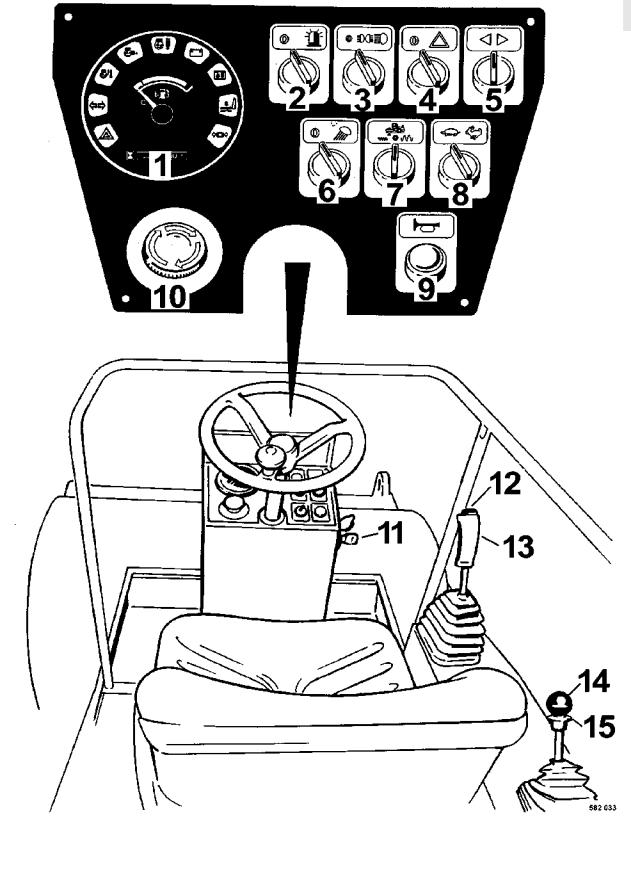
Indicators and Controls
Fig. 5
20 |
BOMAG |
BW 145 D-3/DH-3/PDH-3 |
|
|
|
Indicators and Controls |
|
|
|
|
1 |
Multi-function display |
8 |
Rotary switch for speed range selection |
2 |
Rotary switch for flashing beacon* |
9 |
Push button for warning horn |
3 |
Rotary switch for lighting (StVZO)* |
10 |
Emergency stop push button |
4 |
Rotary switch for hazard light system* |
11 |
Ignition switch (at the side) |
5 |
Rotary switch for direction indicators left/right* |
12 |
Push button for vibration |
6 |
Rotary switch for working head lights* |
13 |
Travel lever |
7 |
Rotary switch vibration high/low frequency |
14 |
Throttle lever |
|
|
15 |
Locking plate for throttle lever |
*Optional equipment
BW 145 D-3/DH-3/PDH-3 |
BOMAG |
21 |

Indicators and Controls
3.1General notes
Please read this section thoroughly before operating this machine if you are not yet conversant with the indicators and control elements. All functions are described in detail hereunder.
Paragraph 4 Operation contains only concise descriptions of the individual operating steps.
Fig. 6
No. 1 = Multi-function display
i Note
After switching the ignition on all lamps light up for approx. 3 seconds as a self-test.
The control and warning lamps light up while the engine is running:
a= Hazard light switched on
b= Direction indicator switched on
c= Engine oil temperature too high, warning buzzer sounds. Clean engine and radiator
d= Engine oil pressure too low, warning buzzer sounds. Check the engine oil level, if necessary have the engine repaired.
e= Air filter cartridge soiled. Clean, change the cartridge.
f= The battery is not being charged, check the V-belt, if necessary repair the generator.
=Light with ignition on and engine off.
g= Hydraulic oil filter soiled, the warning buzzer sounds. Replace the filter ele-
ment, check the hydraulic system if it comes on too early.
h= not used
i= Brake closed or travel lever in second notched position
j= Fuel level gauge
k= Operating hour meter
Fig. 7
No. 2 = Rotary switch for flashing beacon
Position "left" = Flashing beacon switched off
Position "right" = Flashing beacon switched on
Fig. 8
No. 3 = Rotary switch, lighting (StVZO) *
Position "left" = light off
Position "mid-
dle" = fender lights on, with the ignition switch in position "I" or "P"
Position "right" = travel lights on, with ignition switch in position "I".
*Option
22 |
BOMAG |
BW 145 D-3/DH-3/PDH-3 |

Indicators and Controls
Fig. 9
No. 4 = Rotary switch for hazard light system*
Position "left" = hazard light switched off, the control lights go out.
Position "right" = hazard light switched on, control light 7 on fault monitoring board lights up.
Fig. 10
No. 5 = Rotary switch for direction indicators left / right**
Position "mid- |
|
dle" |
= direction indicator off |
Position "left or
right" = front and rear direction indicators on the respective side light up, the control light 6 in the fault monitoring board flashes
*Option
**Option
Fig. 11
No. 6 = Rotary switch working lights ***
Position "left" = light off
Position "right" = working lights on, with ignition switch in position "I".
Fig. 12
No. 7 = Rotary switch, vibration
Position "mid- |
|
dle" |
= vibration off |
Position "left" = low amplitude, high frequency Position "right" = high amplitude, low frequency
*** Option
BW 145 D-3/DH-3/PDH-3 |
BOMAG |
23 |

Indicators and Controls
Fig. 13
No. 8 = Rotary switch for speed range selection
Position "turtle" = Working speed
Position "rab- |
|
bit" |
= Transport speed |
Fig. 14
No. 9 = Push button for warning horn
Fig. 15
No. 10 = Emergency stop switch
The engine will be shut down and the brake will close.
! Danger
Danger of accident!
Operate only in emergency situations during operation, do not use as a service brake.
The machine should only be started again after the danger, that caused the actuation of the emergency stop switch, has been removed.
operate |
= push the button completely |
|
down, it will automatically lock |
|
in end position. |
unlock |
= turn the button clockwise and |
|
release it. |
to drive |
= move the travel lever first to |
|
braking position, then start the |
|
engine and choose the travel |
|
direction. |
For safety reasons the travel system of the machine will only be enabled after the travel lever has been shifted back to braking position.
Fig. 16
No. 11 = Ignition switch
Position "P"/"0" = Ignition off, key can be pulled out, engine off
Position "I" |
= Ignition on, all control and |
|
warning lights in the multi- |
|
function display light up for a |
|
moment |
i Note
The engine can only be started if both travel levers are in “neutral”.
24 |
BOMAG |
BW 145 D-3/DH-3/PDH-3 |
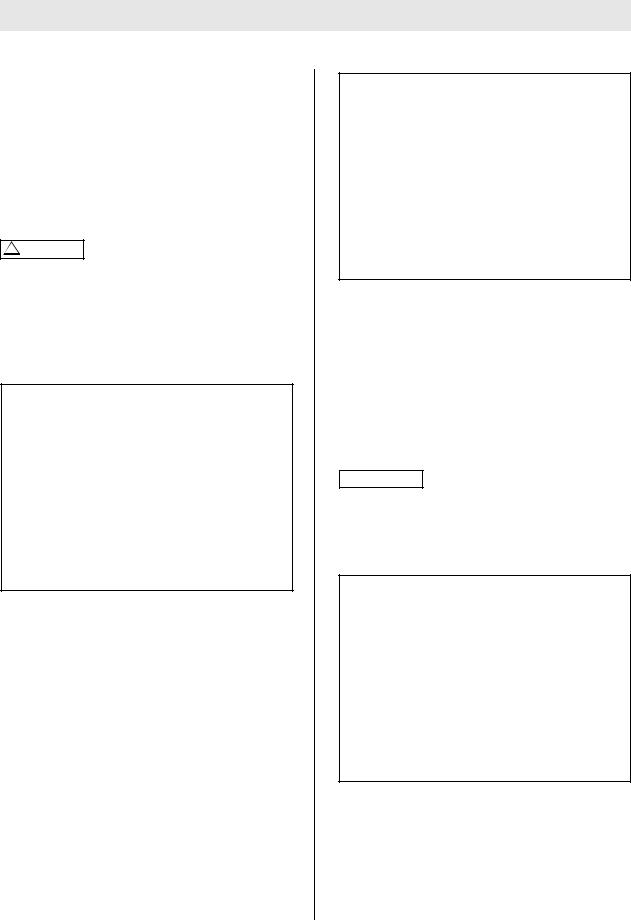
The ignition switch is designed with a lock to prevent repetitive starting. For a new starting attempt the ignition key must first be turned back to position "0".
Position "II" |
= turn further against spring |
|
pressure, he engine starts, |
|
turn the ignition key back to |
|
position once the engine has |
|
started |
!Caution
Run the engine warm for a short while before starting work. Do not allow the engine to run longer than 10 minutes with idle speed.
Do not shut the engine down all of the sudden from full speed, but let it idle for a while for temperature equalization.
Fig. 17
No. 12 = Push button for vibration
•Select or actuate the frequencies with the vibration selector switch.
•Switch the vibration on or off by pressing the push button.
Indicators and Controls
Fig. 18
No. 13 = Travel lever
Position "mid- |
|
dle" |
= Braking position service brake |
Position "middle,
right" = Parking brake, to start the engine
Position "I" |
= Forward travel |
Position "II" = Backwards travel
i Note
If the engine speed drops under load when driving on steep gradients, take the travel lever slightly back towards neutral. This relieves the hydraulic system and the diesel engine.
Fig. 19
No. 14 = Throttle lever
Position "I" |
= |
Idle speed position |
Position "II" |
= |
Full load position, operating |
|
|
position for driving and vibra- |
|
|
tion |
BW 145 D-3/DH-3/PDH-3 |
BOMAG |
25 |

Indicators and Controls
!Caution
Always drive and vibrate with max. engine speed! Control the travel speed only with the travel lever!
No. 15 = Locking plate for throttle lever
pull |
= |
The throttle lever can be |
|
|
moved to position "II" |
release |
= |
The throttle lever locks in posi- |
|
|
tion "II". |
|
|
|
|
|
|
Fig. 20
No. 16 = Fuses in electric installation box
F03, 15A = |
Vibration |
F05, 25A = |
Socket |
F13, 30A = |
Starting |
F19, 15A = |
Working head lights* |
F22, 15A = |
Working head lights, rear* |
F24, 15A = |
Monitoring, gauges |
F25, 15A = |
Solenoid valve brake/travel |
! Danger
Fire hazard!
Do not use fuses with higher ampere ratings and do not bridge fuses.
Fig. 21
No. 17 = Main fuse for battery
125A = (F00)
i Note
The main fuse is located in the battery box under the driver’s seat
Fig. 22
No. 18 = Pedal for dozer blade*
Position "0" |
= Stop position. Dozer blade at |
|
|
|
rest |
Position "I" |
= |
Dozer blade up |
Position "II" |
= |
Dozer blade down |
Position "II" |
= Float position to level loose |
|
|
|
soil when driving in reverse |
! Danger
Danger of squashing!
Do not work under the lifted, unsupported dozer blade, support the blade if necessary.
*Optional equipment
26 |
BOMAG |
BW 145 D-3/DH-3/PDH-3 |
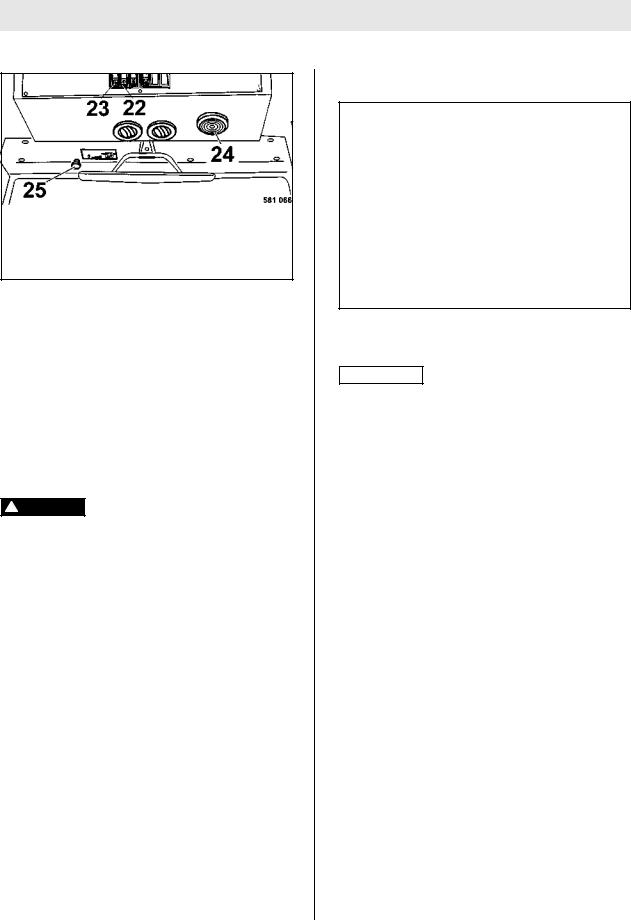
Fig. 23
No. 19 = Fuse box, cabin*
(1) - |
= not used |
(2)7,5A = Inside light
(3)7,5A = Windscreen wiper/washer,
rear
(4) 7,5A = Windscreen wiper/washer, front
(5) 7,5A = Flashing beacon
(6) 7,5A = Heating blower, radio
! Danger
Fire hazard!
Do not use fuses with higher ampere ratings and do not bridge fuses.
No. 20 = Toggle switch, heating blower No. 21 = Toggle switch, flashing beacon**
No. 22 = Toggle switch, windscreen wiper/ washer, front***
No. 23 = Toggle switch, windscreen wiper/ washer, rear****
No. 24 = Cabin light
switch on |
= |
turn lamp glass clockwise |
switch off |
= |
turn lamp glass counter-clock- |
|
|
wise |
No. 25 = Vent for fresh air intake
to operate the slide loosen the adjustment button. slide to the left = air circulation position
slide to the right = fresh air position
*Optional equipment
**Option
***Option
****Option
Indicators and Controls
Switch on the auxiliary hot air blower
Fig. 24
No. 26 = Shut-off valve for cabin heater*****
i Note
The heat exchanger of the cabin heater receives the heat energy from the lubrication oil in the engine.
Position "I" |
= |
Cabin heater switched off |
Position "II" |
= |
Cabin heater full power |
*****Optional equipment
BW 145 D-3/DH-3/PDH-3 |
BOMAG |
27 |

Indicators and Controls
28 |
BOMAG |
BW 145 D-3/DH-3/PDH-3 |
